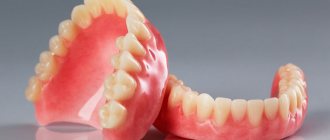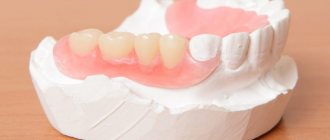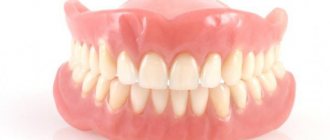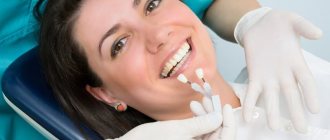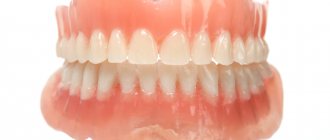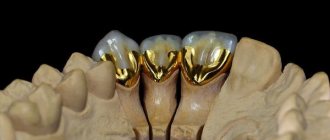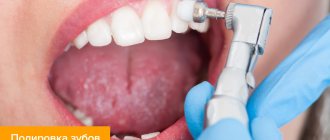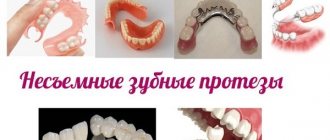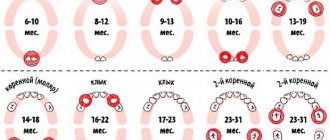Fixed dentures, in comparison with removable dentures, have a longer service life, are more comfortable to wear, are better fixed, and have an aesthetic advantage. In addition, they help keep bone tissue healthy and prevent its atrophy.
The non-removable option of orthopedic treatment is suitable for young and middle-aged people, as well as anyone who suffers from intolerance to removable structures. Optimal for public people due to its aesthetic qualities and the absence of speech problems.
Fixed dentures - features and advantages
Fixed dentures are considered the most effective and inexpensive solution to restore dentition.
The most common causes of tooth decay and subsequent loss are:
- abundant carious lesions;
- pulpitis;
- periodontitis;
- dental cysts, etc.
As a result of these dental diseases, tooth crowns and roots are destroyed, teeth fall out on their own, or surgical intervention is required to remove dead hard tissues and roots. For restoration, the dentist recommends permanent dental prosthetics, the basis of which is a bridge and ceramic crowns of the latest generation.
Advantages of fixed dentures:
- Aesthetics. Fixed dentures are difficult to distinguish from your teeth. With proper selection and proper installation, the design looks harmonious in the oral cavity, and the person smiles boldly.
- Comfort. A person quickly gets used to a fixed denture and does not feel discomfort afterwards.
- There is no need to build up bone for high-quality implementation of a fixed denture. When using modern artificial roots, there is often no need to build up bone tissue. This simplifies the entire dental procedure and makes it much more affordable.
- Fast payback. The investment in fixed dentures always pays off in dental health, attractive visual effect and durability.
Indications for the use of fixed structures
The essence of permanent prosthetics is to install a dental structure in place of a missing tooth fragment or to fill missing units for a long time.
When wearing a prosthesis, there is no need to periodically remove it from the jaw to perform hygienic procedures.
Experts have identified the following indications for the use of this method of dentition restoration:
- defects of the anterior or chewing units with the extent of the affected area exceeding 1/3 of the part;
- in case of partial destruction of the bone tissue of the tooth, when it is possible to preserve the root system;
- with the loss of one tooth or several located in a row;
- if teeth are completely missing.
Orthopedic dentist about fixed dentures:
The main types of permanent dental crowns
At the stage of planning treatment with a fixed denture, the dentist, together with the patient, decides which type of fixed dental crown to use for high-quality prosthetics.
Currently, the most common fixed dentures are:
- Teeth crowns
They are used if the hard tissues of your tooth are destroyed by more than 2/3. The implementation of this type of fixed dental prosthetics occurs as follows:
- the tooth is strengthened with a supporting core and a fiberglass dental pin;
- the tooth is ground down;
- the dentist makes impressions of the tooth;
- After a week or two, a ceramic crown or one made of metal ceramics, plastic, zirconium dioxide, etc. “sits” on your tooth.
- a person receives a new healthy tooth that does not differ from his own either visually or in functional characteristics.
- Veneers – as a type of fixed denture
- their teeth are prepared;
- a thin ceramic onlay is fixed on the surface of pre-selected teeth;
- within a few hours the patient receives an impeccable effect - even, snow-white and beautiful teeth.
A veneer is a thin ceramic inlay that perfectly matches the shape, color, and transparency of your tooth. Such a fixed denture “sits” with the help of a special dental glue on the front wall of a previously ground tooth. Recently, super-thin permanent dental veneers have appeared, which practically do not require grinding of their crown, do not stick out, and look organic. As a rule, veneers are placed on the front six to ten teeth of the upper jaw (smile area). If the lower teeth are in good condition, whitening them is enough to achieve the ideal effect.
Installation of fixed dentures and veneers occurs as follows:
The average lifespan of veneers with proper use is up to 10 years.
Restoring ceramic inlays are used when more than ½ of the tooth crown is destroyed. Dental micro dentures are made from individual dental impressions in dental laboratories, fixed using a special dental bond, and prevent the occurrence of recurrent caries on the teeth.
Advantages of ceramic inlays (mini dentures) compared to composite fillings:
- high strength;
- durability of teeth (on average, from 3 years);
- ceramic systems do not absorb pigments and do not darken;
- retain their qualities throughout the entire period of validity.
Popular questions
Can diction problems occur after fixed bridge prosthetics?
The bridge refers to fixed prostheses that replace the lost part of the dentition, while repeating the anatomical curves of the missing units. The fixation of such products is reliable, so there are no prerequisites for changing diction after installing the bridge.
How many teeth are needed for fixed prosthetics?
Fixed prosthetics are performed in the absence of one or more teeth (no more than three). It is possible to completely restore the jaw with the help of implants, which serve as supporting elements for the prosthesis.
Which fixed dentures are better? Which are the most modern?
Implants with a crown are considered the most reliable fixed prostheses. The implanted pin performs the function of a root, which prevents tissue atrophy. In addition, neighboring teeth are not subjected to grinding, and when chewing food, the load is distributed evenly over the entire jaw. Choosing a material for a crown is also not easy, because each option has its own advantages.
If we take an equal ratio of price and quality, then we should give preference to metal ceramics. More expensive, but modern, is zirconium dioxide, which can compete with ceramics.
Are there any nuances for the upper and lower jaw?
With removable dentures, there are differences between the upper jaw and the lower jaw. This is explained by the presence of a lingual frenulum at the bottom of the oral cavity, which reduces the free area for the placement of plates and bridges of the prosthesis.
When installing permanent structures, the location of the row does not matter much. Fixation of permanent dentures is carried out on implants, the remainder of the tooth or adjacent units. The palate and lower parts of the oral cavity do not take any part in the process.
Classic dental bridge or fixed dental bridge
A classic bridge is a one-piece denture structure consisting of a base, as well as functional and supporting crowns. Functional crowns replace lost teeth, and abutment crowns serve as the basis for securely holding a fixed denture in the oral cavity.
Why do patients choose dental bridges?
- Deadlines. Prompt production of individual impressions in a dental laboratory - up to 14 working hours. days. With additional payment and comfortable conditions, it is possible to produce a fixed denture in 3–5 days.
- Indications for implantation. A fixed dental prosthesis is an excellent replacement system for diagnoses where there are restrictions on the implementation of titanium dental implants and the installation of crowns on these artificial roots.
- Price. The cost of a classic bridge is several times cheaper than the price of a titanium implant and a metal-ceramic or zirconium dioxide crown.
- No age restrictions. Bridges are often staged for both older people and middle-aged audiences.
The nuances of using a dental bridge with pre-implantation:
- You have to grind down your supporting teeth, albeit a little;
- It is often necessary to first remove the roots of the teeth before implantation.
Fixation Features
The peculiarities of fixing fixed dentures are that the installation of some of their types requires grinding of the supporting teeth.
We are talking about veneers (the only exception is very thin Hollywood veneers, which do not require any enamel treatment), crowns and bridges. In the last two cases, removal of the nerve and filling of the canals of the supporting teeth are often required.
After such preparation, the teeth will no longer be able to function fully if the veneer, crown or bridge is removed from them.
Adhesive fixed bridge prosthesis
An adhesive fixed denture got its name due to the peculiarities of fixation on the supporting teeth. To connect it with living tooth tissues, adhesion is used, that is, “sticking” technology. For reliable bonding, the prosthetist uses a dental primer, bond, some types of acids (for example, phosphoric acid), chemical or light-curing cement.
Adhesion helps to secure the ceramic tooth and onlay processes to the supporting teeth without removing the roots and grinding away a large layer of its enamel.
Structure of an adhesive dental bridge:
- main abutment tooth;
- side linings in the form of processes (petals), onto which a fixing compound is applied.
The average lifespan of an adhesive dental bridge is up to five years.
Manufacturing and installation procedure
Stages of manufacturing microprostheses, bridges and crowns:
- Tooth preparation (removal of hard tooth tissue, if necessary).
- Making an impression of the prepared tooth.
- Fixation of a temporary prosthesis (made of plastic, filling material).
- Making a permanent prosthesis.
- Fitting.
- Installation.
Dentures on implants are installed differently:
- Implantation.
- Making a prosthesis.
- Fixation of the prosthesis on implants.
Fixed denture on titanium implants
Fixed dentures on dental implants are one of the most common systems for restoring lost teeth.
The main advantages of such solutions:
- titanium implants installed in deep bone layers preserve hard tissue around them;
- healthy supporting teeth do not require preliminary grinding and root removal;
- the average shelf life of such dentures on artificial roots is twenty years;
- the method of restoring teeth with fixed dentures is considered the most gentle and natural;
- ready-made solution for restoring edentulous teeth;
- attractive dental aesthetics.
The only caveat when installing a fixed dental structure on implants is the considerable cost of the solution.
If we compare all the existing options for fixed dental prosthetics, it is the fixed prosthesis on a dental implant that is the best solution - in terms of quality, aesthetics, reliability and durability of the teeth.
Advantages and disadvantages
Fixed structures are characterized by the following advantages:
- high aesthetic effect (they look more natural than removable ones, they also do not have any fastenings that are noticeable to others);
- long service life (removable structures last an average of 5 years, while ceramic microprostheses and crowns last 10, 15 and some even 20 years, and implants last a lifetime);
- strong fixation (unlike removable options that can fall out);
- ease of care (they do not need to be removed several times a day, like removable ones);
- prevention of bone tissue atrophy (fixed dentures take on the chewing load, preventing bone loss).
Flaws:
- high cost (microprostheses are 2-4 times more expensive than fillings, implant-based prostheses are 4-5 times more expensive than removable plate ones);
- irreversibility of processing of supporting teeth (teeth ground for veneers or crowns forever lose their functional and aesthetic qualities).
How to care for fixed dentures?
Basic rules for proper care of fixed dentures at home:
- brushing teeth with a brush and dental floss;
- using a dental irrigator (preferably after every meal);
- hygienic cleaning of the tongue.
- preventive visits to the dentist’s office (at least twice a year) to control the quality, reliability of fastening and aesthetics of a fixed dental prosthesis (bridge);
Don't forget to clean the surface of your tongue, where just as many bacteria accumulate as on your teeth and gums. These organisms provoke the development of caries. To clean your tongue at home, use a hygienic scraper with a rough surface, which can be purchased at a clinic or any pharmacy.
If the patient wears fixed dental prostheses made of metal-ceramics or ceramic crowns, experts recommend checking the so-called supercontacts (heightened areas of the bridge) at least 2 times a year and grinding them to avoid chips and mechanical damage to the dental bridge.
If you feel that the bridge or individual teeth have begun to loosen, you should urgently consult a dentist. In case of mechanical damage to a fixed denture, the defects can be eliminated without replacing the structure with a new one. If you lose time, you will have to resort to dental prosthetics again using a new bridge.
Types of structures
Due to the variety of dental cases characterized by the need for prosthetics, various technologies and materials are used to create prostheses. From the point of view of design specifics, there are:
- Veneers and lumineers are thin plates made of ceramics used to hide visually noticeable defects in the frontal units;
- Crowns and inlays are products used as a protective cover that imitates the natural structure of the tooth and are placed on top of the damaged unit;
- Bridges are structures designed to replace several successively located units fixed on implants or healthy teeth;
- Implants are permanent prostheses used in cases of complete destruction of not only teeth, but also root areas, completely restoring the structure.
The choice of material for manufacturing is determined by technology and also depends on the financial capabilities of the patient. The most common materials include:
- Ceramics - used to create artificial crowns and veneers that are externally indistinguishable from natural tooth enamel. Fixed dentures made from solid ceramics allow you to create an attractive smile, but are not very durable and affordable;
- Metal alloys - the use of precious and ordinary alloys makes it possible to achieve operational reliability and durability of replacement elements, but reduces aesthetic qualities;
- Metal-ceramics is a technology that combines the advantages and hides the disadvantages of the two above-mentioned materials, highly appreciated by dentists and patients.
In addition, the implantation procedure recommended for severe destruction of individual units or complete edentia involves the use of titanium pins. Titanium is durable and reliable, and is fully compatible with body tissues, which makes it possible to integrate and engraft prostheses.
Average price of fixed dentures in Moscow clinics
- Types of dentures
- Efficiency of production
- Qualifications of specialists
- Type of clinic
The price of a fixed denture depends on the following factors:
A budget option is a plastic bridge, which is usually installed as a temporary solution to replace lost teeth. Metal stamped dental bridges are also cheap - from 300 rubles. for one unit. The most expensive are bridges with ceramic crowns, which cost about 30,000 rubles. for 1 tooth.
Fixed dentures are usually made from pre-made impressions in a dental laboratory. The average production time is two weeks, but some services offer to speed up this process for a fixed additional payment (from 1/3 of the cost to double the price, depending on the complexity of the work).
Dental prosthetics requires the help of several specialists: a prosthetist, an implantologist, and a dental technician. The dependence is obvious: the higher the qualifications of the professional, the higher the final price of dental prosthetics.
The price of the same fixed denture in different clinics may differ. If you compare the prices of Moscow dentists, the most favorable prices are from the network of dental clinics “32 Dent”.
Criterias of choice
Each patient has the right to choose the best option for a prosthesis to restore the dentition, however, in this matter the final word remains with the specialist. A qualified doctor takes into account the following criteria :
- tooth location;
- number of missing teeth;
- condition of dentin and periodontium;
- the condition of neighboring units that can be used as support;
- Expected Result;
- budget.
To restore chewing teeth with incomplete destruction of bone tissue, inlays are recommended. Veneers are more suitable for eliminating defects in the front incisors. If several units are missing in a row, then it is worth considering the option of a bridge or crowns on implants.
